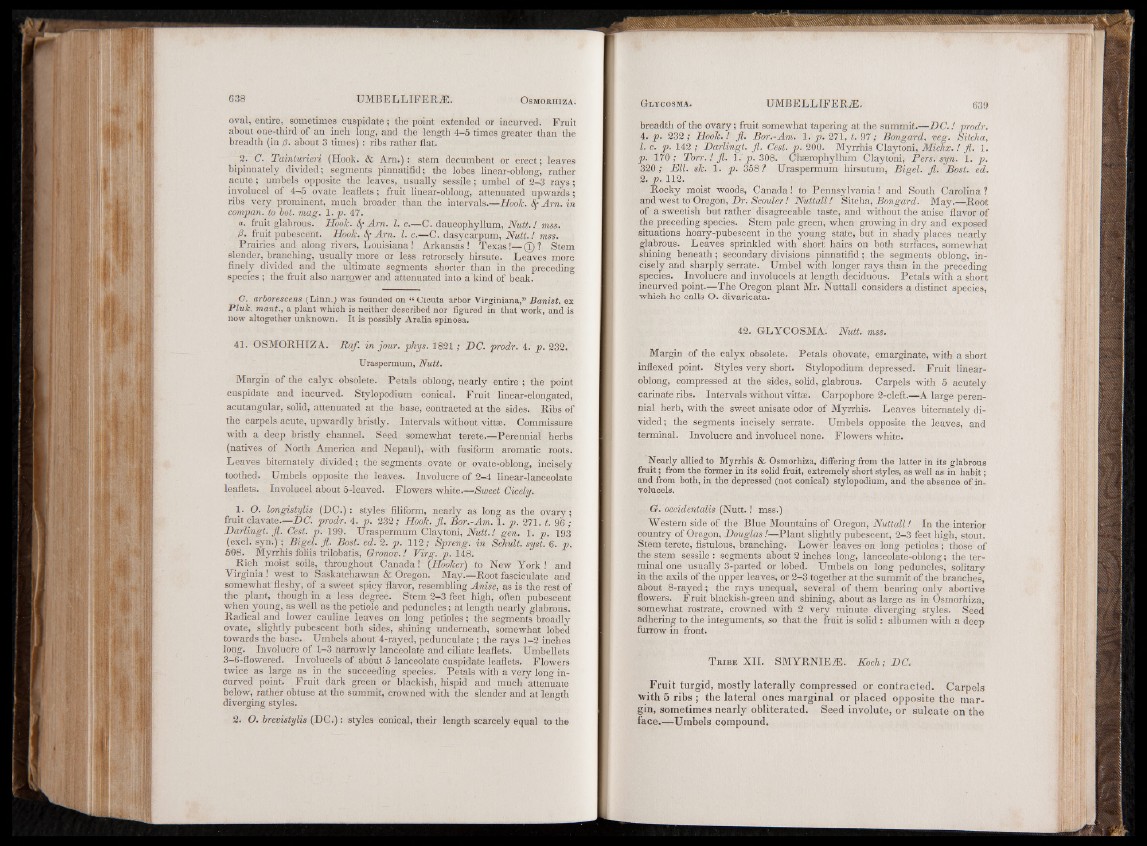
oval, entire, sometimes cuspidate; the point extended or incurved. Fruit
about one-third of an inch long, and the length 4-5 times greater than the
breadth (in 0. about 3 times) : ribs rather flat.
2. C. Tainturieri (Hook. & Arn.): stem decumbent or erect; leaves
bipinnately divided; segments pinnatifid; the lobes linear-oblong, rather
acute; umbels opposite the leaves, usually sessile; umbel of 2-3 rays;
involucel of 4-5 ovate leaflets; fruit linear-oblong, attenuated upwards;
ribs very prominent, much broader than the intervals.—Hook. Sf Arn. in
convpan. to lot. mag. 1. p. 47.
a. fruit glabrous. Hook. <$• Arn. 1. c.—C. daucophyllum, Nutt.! mss.
0. fruit pubescent. Hook. Sf Arn. 1. c— C. dasycarpum, Nutt.! mss.
Prairies and along rivers, Louisiana! Arkansas! Texas!— (T) ? Stem
slender, branching, usually more or less retrorsely hirsute. Leaves more
finely divided and the ultimate segments shorter than in the preceding
species ; the fruit also narrower and attenuated into a kind of beak.
G. arborescens (Linn,) was founded on “ Cicuta arbor Virginiana,” Banist. ex
Pluk. mant., a plant which is neither described nor figured in that work, and is
now altogether unknown. It is possibly Aralia spinosa.
41. OSMORHIZA. Raf. in jour. phys. 1821; DC. prodr. 4. p. 232.
Uraspermum, Nutt.
Margin of the calyx obsolete. Petals oblong, nearly entire; the point
cuspidate and incurved. Stylopodium conical. Fruit linear-elongated,
acutangular, solid, attenuated at the base, contracted at the sides. Ribs of
the carpels acute, upwardly bristly. Intervals without vittae. Commissure
with a deep bristly channel. Seed somewhat terete.—Perennial herbs
(natives of North America and Nepaul), with fusiform aromatic roots.
Leaves bitemately divided; the segments ovate or ovate-oblong, incisely
toothed. Umbels opposite the leaves. Involucre of 2-4 linear-lanceolate
leaflets. Involucel about 5-leaved. Flowers white.—Sweet Cicely.
1. O. longistylis (DC.): styles filiform, nearly as long as the ovary;
fruit clavate.—DC. prodr. 4. p. 232; Hook. jl. Bor.-Am. 1. p. 271. t. 96 ;
Darlingt. jl. Cest. p. 199. Uraspermum Claytoni, Nutt.! gen. 1. p. 193
(excL syn .); Bigel. jl. Bost. ed. 2. p. 112; Spreng. in Schult. syst. 6. p.
508. Myrrhis foliis trilobatis, Gronov.! Virg. p. 148.
Rich moist soils, throughout Canada | (Hooker) to New York ! and
Virginia! west to Saskatchawan & Oregon. May.—Root fasciculate and
somewhat fleshy, of a sweet spicy flavor, resembling Anise, as is the rest of
the plant, though in a less degree. Stem 2-3 feet high, often pubescent
when young, as well as the petiole and peduncles; at length nearly glabrous.
Radical and lower cauline leaves on long petioles; the segments broadly
ovate, slightly pubescent both sides, shining underneath, somewhat lobed
towards the base. Umbels about 4-rayed, pedunculate ; the rays 1-2 inches
long. Involucre of 1-3 narrowly lanceolate and ciliate leaflets. Umbellets
3-6-flowered. Involucels of about 5 lanceolate cuspidate leaflets. Flowers
twice as large as in the succeeding species. Petals with a very long incurved
point. Fruit dark green or blackish, hispid and much attenuate
below, rather obtuse at the summit, crowned with the slender and at length
diverging styles.
2. O. brevistylis (D C .): styles conical, their length scarcely equal to the
breadth of the ovary; fruit somewhat tapering at the summit.—DC. ! prodr.
4. p. 232; Hook.! jl. Bor.-Am. 1. p. 271, t. 97; Bongard, veg. Sitcha,
1. c. p. 142 ; Darlingt. jl. Cest. p. 200. Myrrhis Claytoni, Micnx. ! jl. 1.
p. 170; Torr.! jl. U p . 308. Chserophyllum Claytoni, Pers. syn. 1. p.
320 ; Ell. sic. 1. p. 358 ? Uraspermum hirsutum, Bigel. jl. Bost. ed.
2. p. 112.
Rocky moist woods, Canada! to Pennsylvania! and South Carolina ?
and west to Oregon, Dr. Scouler! Nuttall! Sitcha, Bongard. May.—Root
of a sweetish but rather disagreeable taste, and without the anise flavor of
the preceding species. Stem pale green, when growing in dry and exposed
situations hoary-pubescent in the young state, but in shady places nearly
glabrous. Leaves sprinkled with short hairs on both surfaces, somewhat
shining beneath; secondary divisions pinnatifid ; the segments oblong, incisely
and sharply serrate. ‘Umbel with longer rays than in the preceding
species. Involucre and involucels at length deciduous. Petals with a short
incurved point.—The Oregon plant Mr. Nuttall considers a distinct species,
which he calls O. divaricata.
42. GLYCOSMA. Nutt. mss.
Margin of the calyx obsolete. Petals obovate, emarginate, with a short
inflexed point. Styles very short. Stylopodium depressed. Fruit linear-
oblong, compressed at the sides, solid, glabrous. Carpels with 5 acutely
carinate ribs. Intervals without vittse. Carpophore 2-cleft.—A large perennial
herb, with the sweet anisate odor of Myrrhis. Leaves biternately divided;
the segments incisely serrate. Umbels opposite the leaves, and
terminal. Involucre and involucel none. Flowers white.
Nearly allied to Myrrhis & Osmorhiza, differing from the latter in its glabrous
fruit; from the former in its solid fruit, extremely short styles, as well as in habit;
and from both, in the depressed (not conical) stylopodium, and the absence of involucels.
G. occidentalis (Nutt.! mss.)
Western side of the Blue Mountains of Oregon, Nuttall! In the interior
country of Oregon, Douglas!—Plant slightly pubescent, 2-3 feet high, stout.
Stem terete, fistulous, branching. Lower leaves on long petioles; those of
the stem sessile : segments about 2 inches long, lanceolate-oblong; the terminal
one usually 3-parted or lobed. Umbels on long peduncles, solitary
in the axils of the upper leaves, or 2-3 together at the summit of the branches,
about 8-rayedy the rays unequal, several of them bearing only abortive
flowers. F ruit blackish-green and shining, about as large as in Osmorhiza,
somewhat rostrate, crowned with 2 very minute diverging styles. Seed
adhering to the integuments, so that the fruit is solid : albumen with a deep
furrow in front.
T ribe XII. SMYRNIEiE. Koch; DC.
Fruit turgid, mostly laterally compressed or contracted. Carpels
with 5 ribs ; the lateral ones marginal or placed opposite the margin,
sometimes nearly obliterated. Seed involute, or sulcate on the
face.— Umbels compound.